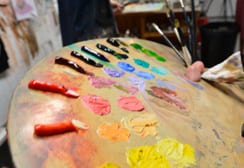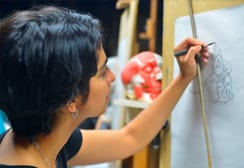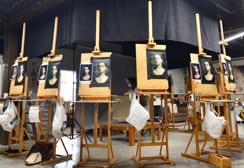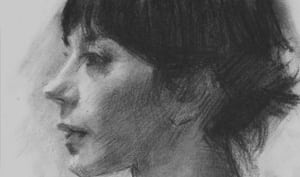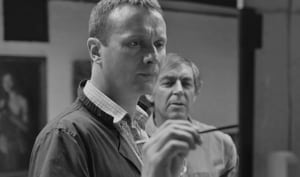Step 7: Painting the Eye, Near Side- Portrait of Lisa
Painting the eye, near side. Involves careful attention to its underlying anatomy, light logic, and edge control. Each form plays a role in creating believable volume, expression, and realism.
- Brow and Brow Ridge
• The brow sits above the eye socket and forms part of the frontal bone.
• The brow ridge often catches direct light and helps indicate the tilt or angle of the head.
• Depending on the lighting, this area may transition into a shadow just beneath the brow (underside), especially in overhead light. - Eye Socket (Orbital Cavity)
• The eye sits within the orbital cavity, a recessed area with soft shadow and reflected light.
• This space defines the overall shape of the eye area and affects how both lids appear in perspective.
• Use subtle transitions from the brow ridge down into the socket to give depth. - Underside of the Brow
• This top plane of the socket curves inward and is often in soft shadow.
• It connects the brow ridge to the upper eyelid, and often reflects cool tones. - Upper Eyelid
• Curves over the spherical form of the eyeball, creating a top and front plane.
• Contains a crease where the lid folds back into the socket—this can cast a soft or sharp shadow depending on the light.
• The edge of the upper lid is usually sharper, especially where the lashes create a cast shadow on the eyeball (sclera). - Lower Eyelid
• Has a bottom-facing plane, often picking up reflected light from the cheek.
• The lower lid is softer in edge than the upper lid.
• Avoid using pure white here—the color should reflect surrounding tones and have subtle warmth or coolness. - Tear Duct (Medial Canthus)
• A small but important anatomical landmark.
• Often pinkish or reddish in tone and sits between the upper and lower lids at the inner corner.
• Keep edges soft—this area is delicate and slightly moist, with subtle temperature and value shifts. - Outer Corner (Lateral Canthus)
• The eye tapers slightly upward and outward here.
• This area usually falls into soft shadow, and often blends into the temple or cheek.
• Keep it understated—sharp edges or high contrast here can make the eye look overly stylized. - Eyeball and Iris
• The eyeball is a sphere—treat it with form logic, not just a flat white space.
• The iris sits embedded in the front, and the upper lid casts a shadow over its top edge.
• Use subtle shifts in value to model the roundness of the eye and a sharp highlight for a glassy effect (placed according to your light source). - Lashes (Optional Detail)
• Use suggestion, not precision—indicate them with soft directional marks or accents.
• Be mindful not to overpower the eye’s form with overdrawn lashes.
Final Tip:
Use a combination of soft and sharp edges to direct focus. Keep soft transitions in the socket and lower lid, while using sharper accents around the upper lid crease, lash line, and the iris highlight.
Would you like a labelled diagram or simplified checklist version of this breakdown for your course?


